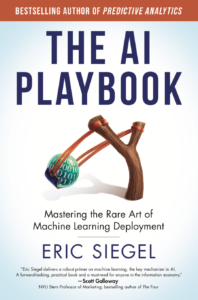This article reviews the new book, The AI Playbook, by my colleague here at The Machine Learning Times, Executive Editor Eric Siegel.
Free book: Come to Machine Learning Week – June 4-7, 2024 in Phoenix, AZ – to meet author Eric Siegel, the event founder, and receive a complimentary copy.
–Luba Gloukhova, Editor-in-Chief
This article has been automatically translated from Korean to English with Google Translate.
In my 30 years of studying, researching, and applying machine learning models for prediction, recommendation and anomaly detection in various business environments, I’ve consistently felt that there are too few people who understand why they are trying to implement this technology. Whether they are data scientists (now often referred to as data analysts), users or managers who need to use the results of machine learning, or executives who approve the projects, almost all have little to no understanding of what they are creating, why they are creating it, or what results ML should deliver.
‘The AI Playbook’ is a book about the application of machine learning in real organizations, calmly explaining many very important and fundamental aspects that most data scientists, machine learning engineers, managers, and various practitioners – in other words, the ultimate users of machine learning – do not know or overlook.
Among the many precious stories this book discusses, let’s examine a few. Elevating human understanding and leadership is more crucial for the success of machine learning than the technology itself . When business leaders are presented with a model as the outcome of an enthusiastically initiated project, they often reject its deployment. This rejection stems not only from technical limitations but also from a lack of understanding of ML’s value within the organization.
The first step of ML is to define the goal. This involves defining the business value proposition and deciding how ML will improve the task (when deployed). However, less than half of the decision-makers in organizations understand data and the stories conveyed through visualization and models. If this issue is not addressed, ML can become meaningless, a waste of resources, or worse, a source of misinformation causing problems within the organization.
I believe that the CRISP-DM, introduced in the 1990s, was a groundbreaking work for its time, offering innovative ideas and well-defined procedures. It was significant because it added a step to the then prevalent methodology of statistical analysis and machine learning, which was technology-centric, to realize the business objectives and expected outcomes, thereby clarifying why organizations use technology.
However, it’s regrettable that even after a considerable time, practices for applying ML in business have not become standardized or universally adopted. ‘The AI Playbook’ is built on the foundation of bizML, which is the culmination of the author’s extensive practical experience aimed at complementing and expanding CRISP-DM.
The philosophy of bizML is that in business, one should focus on the final decision-making and work backwards from there. It emphasizes the need to first define and start with how the business aspect should be changed through the technology of ML. I completely agree that setting the goals of ML deployment through reverse planning can keep the project on the right track. Analysts who have experienced both failures and successes in ML intuitively or instinctively work in this manner, even if they do not directly learn and apply such specific frameworks or methodologies. This is because it is a natural flow for successful ML project execution.
‘The AI Playbook’ meticulously explains how the ML process should be implemented in business, using concrete real-life examples such as UPS’s package prediction. Furthermore, the book provides crucial details such as when predictions should be obtained for them to hold business value and what the real business implication of what is commonly referred to as ‘accuracy’ is.
Recently, the spotlight seems to be solely on generative AI like ChatGPT. However, generative AI is also a part of machine learning and shares many potential pitfalls outlined in this book. Therefore, the discussions in this book are essential for those only interested in generative AI.
This book will be immensely helpful for data scientists and machine learning engineers in developing and deploying truly useful machine learning models more effectively in practice. It will also serve as a significant guide for business leaders, managers, and operational staff who aspire to successfully implement machine learning in business, helping them understand the value of machine learning and the necessary actions to take. Furthermore, for end-users of machine learning models, this book will aid in understanding how the models are developed and how their outputs should be interpreted and utilized. Even if the book feels somewhat challenging, I believe that perusing just a third or half of its contents will be undoubtedly beneficial.
About the Author
Yong Xune Xon, CEO of Revision Consulting, has a PhD in business and is a veteran of CRM/target marketing and practical data-driven applications using machine learning. He has developed customer/marketing/campaign strategies and predictive modeling applications like recommenders for clients in various industries, including on/offline retail and credit card. In addition to various education and lectures, he is keeping in touch with practitioners who want to achieve tangible results through columns and books such as ‘CRM2.0 strategies to upgrade customer-oriented management ‘ and ‘big data for CEOs’. In 2023, he published a new field book “ChatGPT Prompt Engineering for Digital Marketers.”






